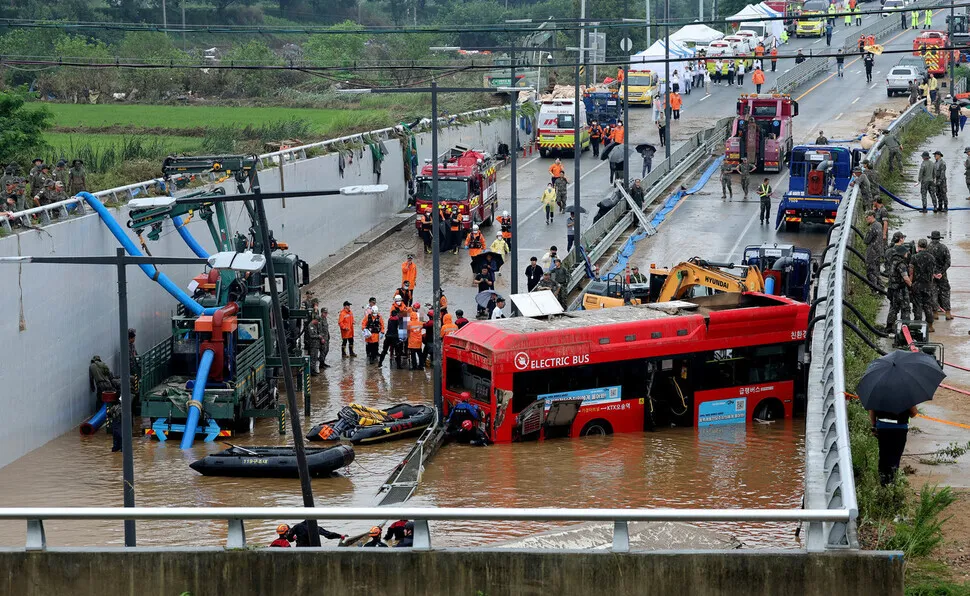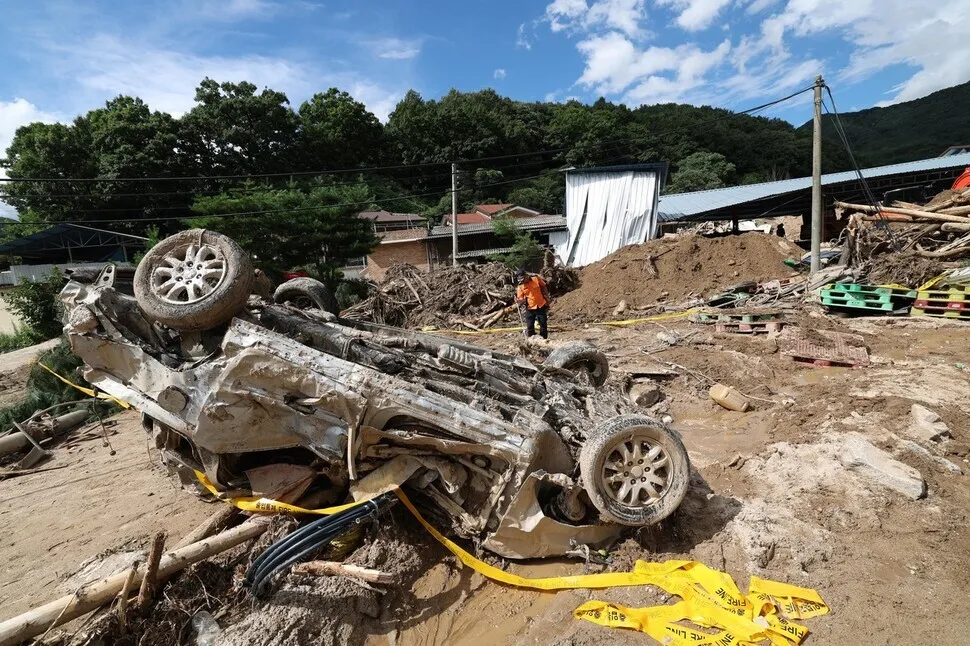hankyoreh
Links to other country sites 다른 나라 사이트 링크
Outdated protocol, shirked responsibility: Deadly underpass flooding is a tragedy of human error

The protocols were outdated, the on-site management unsystematic. The administrative offices that should have been making swift decisions on the ground were irresponsible.
To say this disaster was “man-made” is not enough. This was the sort of disaster found in an underdeveloped country.
The tunnel flooding that claimed 14 lives in the Osong township of Cheongju, North Chungcheong Province, seemed to combine all the different ways in which South Korea’s disaster response systems fail.
After three people were killed by the flooding of the Choryang No. 1 Underpass in Busan in July 2020, the authorities pledged to improve their manual, address their response system, and make the necessary infrastructure additions.
Three years later, five times as many people lost their lives in a similar tunnel flooding in Cheongju on Saturday. When the same mistakes and failures keep repeating, that’s a characteristic of the sort of disaster found in underdeveloped countries.
In 2019, the Ministry of the Interior and Safety assigned three levels to the 145 underpasses nationwide that presented flooding risks. Access was restricted in cases of heavy rainfall warnings.
But no such measures were taken for the Gungpyeong No. 2 Underpass after a flood warning was issued for the nearby Miho River. The reason had to do with the separate protocol developed by the North Chungcheong Province Road Management Office.
The province explained that it did not restrict access to the underpass ahead of time because “our manual states that underpasses are only to be restricted when the center is 50 cm underwater.” This means that they were prepared for some pooling of rainwater, which accumulates slowly — but they had no scenario in place for flooding from a river spilling over.
The same sort of complacency has been observed in the Miho River Bridge expansion and temporary embankment construction project that was launched in February 2018 on the river near the underpass by the National Agency for Administrative City Construction (NAACC). For the sake of convenience, the old embankment was taken down and a temporary one put up in its place.
The new one’s height was 10 meters, or almost 3 meters lower than the original 12.9 meters. The NAACC said it did not predict any issues because the height was still above the anticipated flood water height of 9.3 meters — but it overlooked changing patterns as the climate crisis has progressed.

With over 300 mm (almost 1 foot) of rain falling over a period of four days, the swollen waters easily spilled over the embankment, and once the waterway opened up, the feeble temporary embankment crumbled in no time.
Another issue is that while the infrastructure posed a high inundation risk, responsibility for management and control was dispersed across different parties.
North Chungcheong Province was responsible for managing Route 508, which passes through the tunnel, while the bridge construction project that precipitated the flooding disaster was under the NAACC’s jurisdiction. Responsibility for managing the river that spilled over lay with the Geumgang Basin Environmental Office and the city of Cheongju as the presiding local government.
Those agencies have been busy trying to shift the responsibility in the tragedy’s wake.
The final step leading to catastrophe comes with irresponsibility on the part of the officials in charge.
On two occasions — the earliest four hours before the flooding — the Geum River Flood Control Office alerted the local government of the dangerous situation with the Miho River and stressed the need to restrict traffic and evacuate residents. The presiding Heungdeok District Office consistently denied this on the day of the tragedy, only to finally admit a day later on Sunday that it had indeed been notified.
North Chungcheong Province, which is responsible for managing the underpass and road, similarly refused to acknowledge its responsibility, claiming that the “water came rushing in all at once” and that “nothing could be done.”
Experts say it’s time to adapt to the increasing difficulty of predicting the weather, which is a result of climate change.
“Climate change is the new normal,” remarked Jang Dae-won, head of the LIG System’s institute for disaster safety.
“The ‘top-down,’ bureaucratic responses of the past have reached their limit. We need to build a participatory disaster and safety management system that can counteract risks by incorporating ideas from a range of stakeholders.”
Along with the need to adapt to the changing behavior of disasters, numerous experts spoke of helpful steps that can be taken right away, such as improving emergency response.
“Given the impracticality of preventing property damage under the current heavy rain pattern, our protocols and emergency response efforts need to be reoriented on saving lives,” said Jeong Chang-sam, a professor specializing in smart construction and disaster management at Induk University.
Some say that scrutinizing human-induced changes to the physical environment may be just as important as considering climate change. That’s the viewpoint of Hong Suk-hwan, a professor in the department of landscape architecture at Pusan National University.
After analyzing a landslide that occurred in Yecheon, North Gyeongsang Province, Hong said, “When I examined the top part of the landslide, I found some areas where trees had been cleared from the steep sides of a ravine.”
“We need to change the way we study and manage landslides. We need to focus not on gradients, soil quality and planted trees, but on the places where human behavior has altered the environment,” said Lee Su-gon, a former professor in the civil engineering department at the University of Seoul.
Korea’s Central Disaster and Safety Countermeasure Headquarters said Monday that, as of 8 pm, the number of fatalities resulting from heavy rainfall had increased to 41 (1 in Sejong, 17 in North Chungcheong Province, 4 in South Chungcheong Province and 19 in North Gyeongsang Province).
By Son Ji-min, staff reporter; Park Da-hae, staff reporter; Choi Ye-rin, staff reporter
Please direct questions or comments to [english@hani.co.kr]

Editorial・opinion
![[Correspondent’s column] Coupang’s game in Washington follows familiar pattern [Correspondent’s column] Coupang’s game in Washington follows familiar pattern](https://flexible.img.hani.co.kr/flexible/normal/500/300/imgdb/original/2025/1226/8217667391873536.jpg) [Correspondent’s column] Coupang’s game in Washington follows familiar pattern
[Correspondent’s column] Coupang’s game in Washington follows familiar pattern![[Editorial] Coupang’s attempt to hide behind US won’t win back Korean consumers [Editorial] Coupang’s attempt to hide behind US won’t win back Korean consumers](https://flexible.img.hani.co.kr/flexible/normal/500/300/imgdb/original/2025/1226/1817667387971465.jpg) [Editorial] Coupang’s attempt to hide behind US won’t win back Korean consumers
[Editorial] Coupang’s attempt to hide behind US won’t win back Korean consumers- Coupang under fire for possible obstruction of investigation into its customer data leak
- [Editorial] Coupang founder’s contempt for workers, customer security knows no bounds
- [Column] Confessions of a Coupang-holic
- [Editorial] Kim Bom-suk’s arrogance on full display in boycott of Coupang leak hearing
- [Editorial] The facts of Yoon’s insurrection are clear — justice cannot be further delayed
- [Column] Trump destroys government
- [Column] A post-Western world approaches
- [Column] Offshore balancing, or carving out spheres of influence?
Most viewed articles
- 1Korea to trial next-gen train capable of sub-2-hour Seoul-Busan trip starting 2030
- 2Kim Jong-un’s hidden motive in criticizing South Korea’s nuclear submarine push
- 3[Editorial] Coupang’s attempt to hide behind US won’t win back Korean consumers
- 4Coupang under fire for possible obstruction of investigation into its customer data leak
- 5[Correspondent’s column] Coupang’s game in Washington follows familiar pattern
- 6Real-life heroes of “A Taxi Driver” pass away without having reunited
- 7Moon Jae-in renews call for end-of-war declaration, peace treaty on Korean Peninsula
- 8Chang Chun-ha’s family hopes to know truth of his death after 37 years
- 9Chinese money flooding into South Korean companies
- 10Russian architect personally witnessed Empress Myeongseong’s assassination by Japanese ronin, accoun